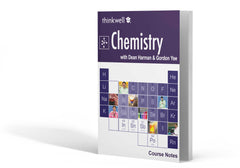
Chemistry compatible with AP®* Online Course
$189.00
Thinkwell's Chemistry compatible with AP®*
The AP® exams are tough, but imagine how much easier they'd be if you had the world's best AP® Chemistry teachers teaching you the fundamentals and advanced concepts of chemistry. Learn the ins and outs of AP® Chemistry from award-winning chemistry professors Gordon Yee and Dean Harman.
The Honors Chemsitry course is here, and here's a comparison of the two courses.
The Printed Notes (optional) are the Thinkwell Honors Chemistry course notes printed in color, on-the-go format.
*(AP® is a registered trademark of the College Board, which was not involved in the production of this product. This course is designed for self-study preparation for the AP® exam and has not been audited by the College Board.)





